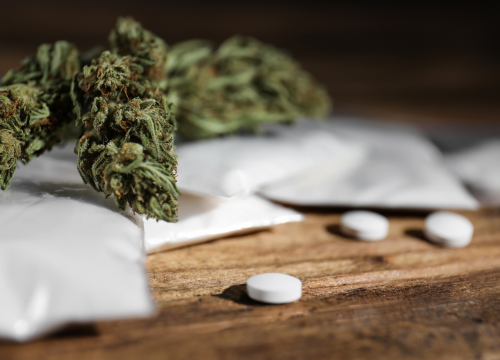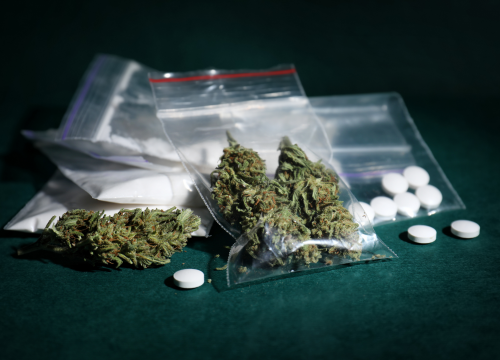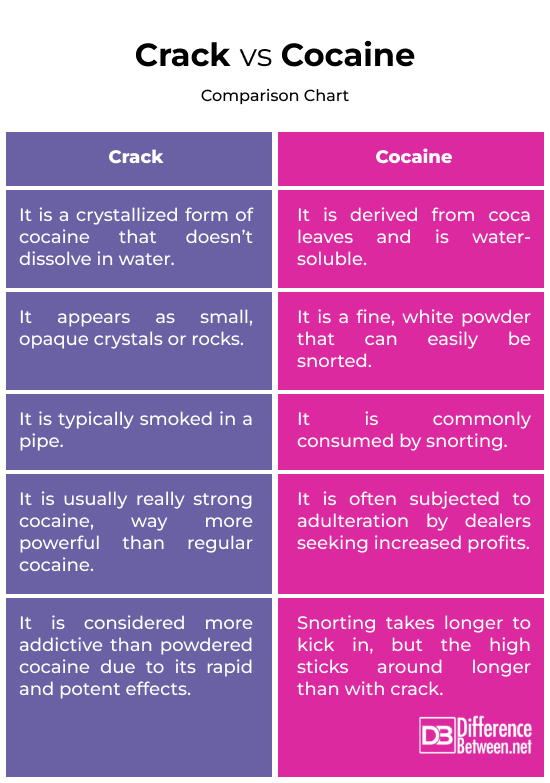Difference Between Crack and Cocaine
Drug addiction is a pressing issue in today’s society, with substances like crack and cocaine playing a prominent role. These stimulant drugs impact the central nervous system and pose a considerable risk of abuse and dependency. Despite their shared classification, crack and cocaine exhibit distinct characteristics. In this article, we’ll delve into the five key differences that set crack and cocaine apart.

What is cocaine?
Cocaine is a naturally occurring stimulant drug extracted from the leaves of the coca plant. First, the leaves are collected, and then they are soaked in a liquid like gasoline to create a paste. This paste is filtered to remove any impurities, leaving behind a liquid with the drug’s main components.
To refine it further, an acid or base is added to this liquid, causing the cocaine to separate. This separated cocaine is then turned into a solid form by drying it. Unfortunately, in the illegal market, people often mix cocaine with other substances like talc or sugar to make more money.

What is crack?
Crack, commonly known as crack cocaine, is a highly potent and illicit form of cocaine. It is created by processing cocaine hydrochloride, the powdered form of cocaine, into a crystallized substance. It is produced by mixing cocaine with baking soda or another alkaline substance and then heating the mixture. This process results in the formation of small, rock-like crystals or “rocks” of crack cocaine.
Crack is typically smoked, delivering an intense and rapid onset of effects compared to powdered cocaine, which is often snorted. The name “crack” comes from the cracking sound produced when the crystals are heated and smoked. This form of cocaine is highly addictive and has a significant potential for abuse.
Difference between Crack and Cocaine
Chemical Composition
While both substances originate from the coca plant and share certain effects, their chemical composition and preparation methods set them apart significantly. Cocaine typically refers to cocaine hydrochloride, a powdered form of the drug. It is derived from coca leaves and is water-soluble, often consumed through snorting.
Crack, on the other hand, is a crystallized form of cocaine. It is created by mixing cocaine with baking soda or another alkaline substance and heating the mixture, resulting in small, rock-like crystals.
Appearance
Cocaine is a fine, white powder that can easily be snorted. It does not have the crystalline structure seen in crack. Crack appears as small, opaque crystals or rocks with a distinct appearance. The name “crack” is derived from the cracking sound it makes when heated for smoking.
Purity Level
Cocaine hydrochloride is relatively purer compared to crack. Cocaine, in its street form, is often subjected to adulteration by dealers seeking increased profits. It’s often cut with substances like talcum powder, baking soda, or other drugs, resulting in widely varying purity levels.
Crack is usually really strong cocaine, way more powerful than regular cocaine. It’s made in small amounts, so there’s less chance of adding other stuff to it. But, because it’s so strong, people who use it are more likely to get addicted compared to other types of cocaine.
Consumption Method
Cocaine is commonly consumed by snorting the powdered form through the nasal passages. This method provides a slower onset of effects. However, it can also be smoked or injected. Injecting cocaine makes you feel high right away, but it’s riskier and can lead to problems like infections or collapsed veins.
Crack is typically smoked in a pipe because it gets into the bloodstream really fast this way, giving a really strong high for a few minutes. Smoking crack is super addictive, and people often end up trying to recreate that first high, getting stuck in a cycle of addiction.
Addiction Potential
While cocaine can be addictive, the process of smoking crack cocaine often leads to a faster and more intense high, increasing the potential for addiction. Prolonged use of cocaine can lead to addiction and withdrawal symptoms. Crack is considered more addictive than powdered cocaine due to its rapid and potent effects, making users more prone to compulsive and frequent use.
Crack vs. Cocaine: Comparison Chart

Summary
Cocaine typically refers to the hydrochloride salt form of the drug. It exists as a fine, white powder and is derived through a process involving the coca plant’s leaves. Crack, on the other hand, is a crystallized form of cocaine produced by mixing cocaine powder with baking soda or another alkaline substance and then heating the mixture. Understanding these differences is crucial for recognizing the varied risks associated with the use of both substances and addressing their distinct impact on individuals and communities.
FAQs
How are crack and cocaine produced?
Cocaine is a naturally occurring stimulant drug extracted from the leaves of the coca plant. Crack, on the other hand, is a crystallized form of cocaine produced by mixing cocaine powder with baking soda or another alkaline substance and then heating the mixture.
What do crack and cocaine look like?
Cocaine is a fine, white powder, similar to powdered sugar or flour, whereas crack appears as small, opaque crystals or rocks.
How is crack abused?
Crack cocaine is typically abused by smoking. Powdered cocaine is mixed with water and a base (usually baking soda). The mixture is then heated, resulting in the formation of solid, crystalline rocks or “crack.” The crack rocks are broken into smaller pieces or “rocks.” These rocks are then placed in a pipe or other smoking device.
What are the risks of using crack and cocaine?
The use of crack and cocaine poses various health risks, both short-term and long-term. Cocaine can significantly elevate heart rate and blood pressure, increasing the risk of heart-related issues. Prolonged use can contribute to heart attacks, strokes, and other cardiovascular problems. Smoking crack can result in respiratory problems, including chronic cough and lung damage.
- Difference Between Caucus and Primary - June 18, 2024
- Difference Between PPO and POS - May 30, 2024
- Difference Between RFID and NFC - May 28, 2024
Search DifferenceBetween.net :
2 Comments
Trackbacks
Leave a Response
References :
[0]Marsico, Katie. Cocaine and Crack. Cavendish Square Publishing, LLC, 2014.
[1]Spillane, Joseph F. Cocaine: From Medical Marvel to Modern Menace in the United States, 1884-1920. JHU Press, 2000.
[2]Weiss, Roger D., et al. Cocaine. American Psychiatric Pub, 2002.
[3]Platt, Jerome J. Cocaine Addiction: Theory, Research, and Treatment. Harvard University Press, 1997.
[4]“5 Key Differences Between Crack and Cocaine.” Compassion Behavioral Health, 7 June 2023, compassionbehavioralhealth.com/blog/5-key-differences-between-crack-and-cocaine/.
[5]Image credit: https://www.canva.com/photos/MAFamcFYDBY-cocaine-dried-hemp-and-ecstasy-on-color-background/
[6]Image credit: https://www.canva.com/photos/MAFagWihwJk-cocaine-dried-hemp-and-ecstasy-on-wooden-table-closeup/

I came across the site and really liked the content and the way it was presented. I would like have the content lnked to our site. Please let me know if thats fine and what I need to do for the same. Do you rovide RSS feeds for the use for other websites?